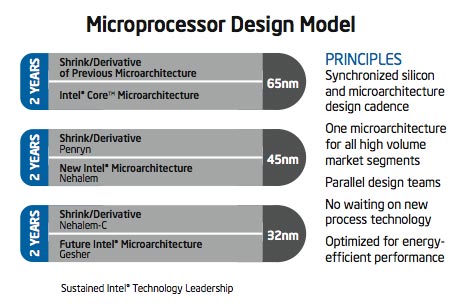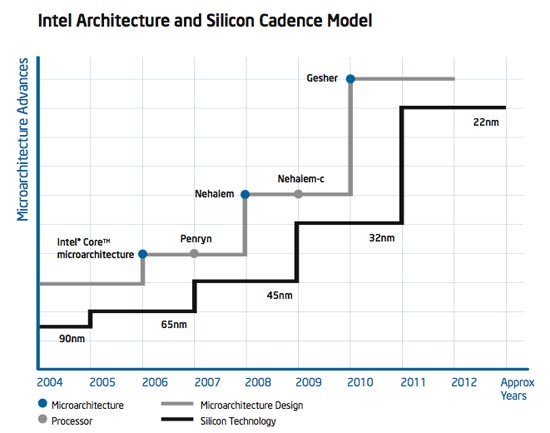Intel's Core 2 Extreme QX6700: The Multi-core Era Begins
by Anand Lal Shimpi on November 2, 2006 2:14 AM EST- Posted in
- CPUs
Analyzing Efficiency Trends
The graph below summarizes the data pretty well; what you're looking at is a graph of normalized performance per watt in six applications as a function of the number of cores in a Core micro-architecture CPU:

The graph illustrates exactly what we've confirmed here today: having more cores does increase efficiency if the software is designed to take advantage of those additional cores.
We have not yet hit the point of diminishing returns with adding more cores, but the two downward trending curves show the current problem with scaling from two to four cores. Very few desktop applications can take good advantage of a dual core CPU and even fewer are geared for quad core chips, and in those applications these quad core processors are actually a step back in terms of efficiency; it's not a fault of the processor, but rather of the software.
Through the benchmarks on the previous page we also highlighted another important point to take away: even in the areas where performance and efficiency were both improved, they came at a very expensive cost: twice the transistor count of Core 2 Duo. As much as Intel may call the next decade the era of multi-core and thread level parallelism, we simply can't lose focus on improving instruction level parallelism and core level efficiency.

Thankfully Intel has recently announced that it will be updating its micro-architecture every two years in an attempt to avoid problems like what happened with NetBurst and the Pentium 4. If it weren't for this change in microprocessor design model, the quest for more cores would end up no differently than the gigahertz race.

If all goes according to plan, it looks like we will get one of those improvements to ILP and core efficiency by the end of 2007/beginning of 2008 with Nehalem in order to avoid hitting another efficiency brick wall.










59 Comments
View All Comments
JJWV - Tuesday, January 23, 2007 - link
I bought a QX6700 for crunching at numbers. The reasoning was simple twice the power, only one MB, disk, PSU, case...The result is disappointing, the maximum throughput I get is not twice an E6700, it is just a little more than one an half : 1,6 to be precise. The bottleneck is definitely the memory. The Northbridge cannot communicate fast enough with the memory. 5I came to this conclusion by varying multiplier, FSB...) Perhaps it would be worthwhile with the faster memory available 9200, but I am afraid even that kind of memory is to slow. The Quadcore is where Intel went over the edge with their memory architecture.
Kougar - Tuesday, November 14, 2006 - link
Any ideas on the Apache benchmarks I am seeing with a QX6700? They are appalling at best, with a QX6700 performing on par to a E6400!! A little of the same problem seems to have shown up in Office Productivity benchmarks. Any thoughts on this?in1405 - Monday, November 6, 2006 - link
<<<No article looking at a new processor release would be complete without benchmarks. However, let us preface the benchmark section by stating that the benchmarks don't tell the whole story. There are numerous benchmarks and tasks that you can run that will actually show quad core processors in a better light. A lot of people will never use the applications related to these benchmarks, so in one sense we could say that most people should already know whether or not they need quad core processing.>>>Some interesting comments here on the relevance of Benchmarks .. This looks interesting as this point of view never came up while the AMD CPUs were being glorified a few months back in this same site!! Wonder where the sudden wisdom comes from.
LTC8K6 - Sunday, November 5, 2006 - link
Why not compare dual to quad by trying to run things in the background while you do something in the foreground? Encode something and play Oblivion, for example. Would we finally be able to do anything like that with quad cores? Are we able to get good framerates in such a situation yet?Webgod - Thursday, November 2, 2006 - link
How about running http://www.driverheaven.net/photoshop/">DriverHeaven.Net's Photoshop CS2 benchmark? I think one of your standard magazine benchmarks has Photoshop 7, but the DH benchmark is newer and it's somewhat popular. Anybody can download a demo from Adobe, and run the benchmark on their own PC.coldpower27 - Thursday, November 2, 2006 - link
Check Intel's current price list here:http://www.intel.com/intel/finance/pricelist/proce...">http://www.intel.com/intel/finance/pricelist/proce...
JarredWalton - Thursday, November 2, 2006 - link
Actually just the 820 and 914 - 805 didn't get a price cut this month. But I fixed the other two, thanks. :)coldpower27 - Thursday, November 2, 2006 - link
oh yeah my bad, didn't mean to add the 805 in there.by the way, check your email please.
OddTSi - Thursday, November 2, 2006 - link
On page 7 you say "Apple's OS X and its applications have also been well threaded for quite some time..." yet the only two Apple apps in the test (Quicktime and iTunes) didn't scale AT ALL from 2 to 4 cores. I'm not trying to bash Apple here I'm just trying to point out that the facts don't seem to support your assertion. If Apple's media rendering apps - which are some of the easiest to multithread - don't scale well I doubt that the rest of their apps do.mino - Thursday, November 2, 2006 - link
Maybe cause there is a catch?You see, WinXP is not very OSX like, not to mention its apps ;)